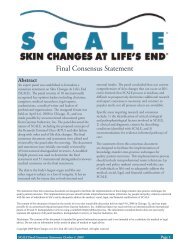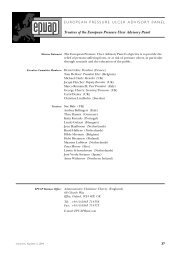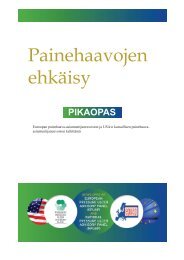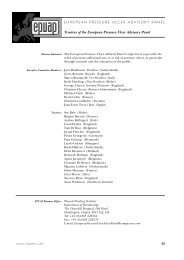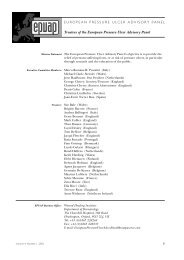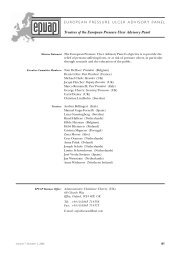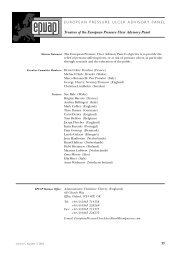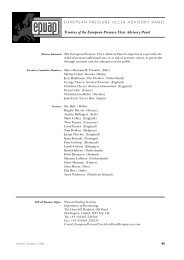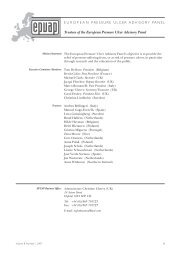EPUAP Review 10.1.indd - European Pressure Ulcer Advisory Panel
EPUAP Review 10.1.indd - European Pressure Ulcer Advisory Panel
EPUAP Review 10.1.indd - European Pressure Ulcer Advisory Panel
You also want an ePaper? Increase the reach of your titles
YUMPU automatically turns print PDFs into web optimized ePapers that Google loves.
PRESSURE ULCER PREVENTION GUIDELINES<br />
It is clear that other and more detailed clinical guidelines on nutrition<br />
and hydration exist and should be available and that this guideline’s<br />
guidance on nutrition and pressure ulcers should be considered within<br />
the context of general guidelines on nutritional management.<br />
SPECIFIC RECOMMENDATIONS<br />
1. Offer high protein mixed oral nutritional supplements and/or tube<br />
feeding, in addition to the usual diet, to individuals with nutritional risk<br />
and pressure ulcer risk because of acute or chronic diseases, or following<br />
a surgical intervention. (Strength of Evidence = A)<br />
Oral nutrition (via normal feeding and/or with additional sip feeding)<br />
is the preferred route for nutrition and should be supported whenever<br />
possible.<br />
Oral nutritional supplements are of value because many pressure ulcer<br />
prone patients often cannot meet their nutritional requirements via<br />
normal oral food intake. Moreover, oral nutritional supplementation<br />
seems to be associated with a significant reduction in pressure ulcer<br />
development compared to routine care.<br />
Enteral (tube feeding) and parenteral nutrition may be necessary when<br />
oral nutrition is inadequate or not possible based on the individual’s<br />
condition and goals.<br />
1.1. Administer oral nutritional supplements (ONS) and/or tube<br />
feeding (TF) in between the regular meals, to avoid reduction of<br />
normal food and fluid intake during regular mealtimes. (Strength of<br />
Evidence = C)<br />
REPOSITIONING FOR THE<br />
PREVENTION OF PRESSURE ULCERS<br />
– REPOSITIONING<br />
1. The use of repositioning should be considered in all at-risk individuals.<br />
1.1. Repositioning should be undertaken to reduce the duration and<br />
magnitude of pressure over vulnerable areas of the body. (Strength of<br />
Evidence = A)<br />
High pressures, over bony prominences, for a short period of time, and<br />
low pressures, over bony prominences, for a long period of time are<br />
equally damaging. In order to lessen the individual’s risk of pressure<br />
ulcer development, it is important to reduce the time and the amount<br />
of pressure they are exposed to.<br />
1.2. The use of repositioning as a prevention strategy must take into<br />
consideration the condition of the patient and the support surface in<br />
use. (Strength of Evidence = C)<br />
REPOSITIONING FREQUENCY<br />
2. Repositioning frequency will be influenced by the individual (Strength<br />
of Evidence = C) and the support surface in use (Strength of Evidence<br />
= A).<br />
2.1. Repositioning frequency will be determined by the individual’s<br />
tissue tolerance, their level of activity and mobility, their general medical<br />
condition, the overall treatment objectives and an assessment of the<br />
individual’s skin condition. (Strength of Evidence = C)<br />
2.2. Assess the individual’s skin and general comfort. If the individual<br />
is not responding as expected to the repositioning regime, reconsider<br />
the frequency and method of repositioning. (Strength of Evidence = C)<br />
2.3. Repositioning frequency will be influenced by the support surface<br />
used. (Strength of Evidence = A)<br />
An individual should be repositioned with greater frequency on a on<br />
a non-pressure-redistributing mattress than on a visco-elastic foam<br />
Volume 10, Number 1, 2009 9



